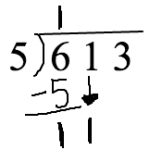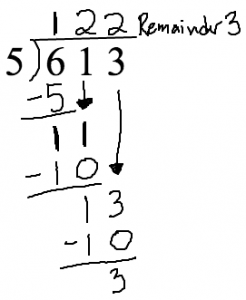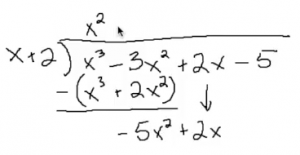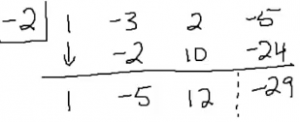Today let’s look at two different types of polynomial division: Polynomial Long Division and Synthetic Division. Long division will work when dividing by any polynomial, synthetic division only works when the divisor is a first degree binomial.
This is definitely a case where the explanation is trickier than the process. If you find the text confusing, start with the video tutorial, and then come back to this written explanation.
Long Division:
It’s likely been a long time since you thought about long division, so let’s refresh first. Imagine ![]() you’re diving 613 by 5. First, set up the problem: put 613 inside and 5 outside.
you’re diving 613 by 5. First, set up the problem: put 613 inside and 5 outside.
 Think about how many times 5 goes into 6 (once), and put that 1 up above the 6. Multiply the 1 by the 5, and put the result, 5, below the 6. Subtract 5 from 6, resulting in 1,
Think about how many times 5 goes into 6 (once), and put that 1 up above the 6. Multiply the 1 by the 5, and put the result, 5, below the 6. Subtract 5 from 6, resulting in 1,  and carry the 1 from 613 down next to it so you have 11. How many times does 5 go into 11? Twice. Put the two up above and multiply it by 5 to get 10, which goes below the 11. Subtract 10 from 11 (resulting in 1), bring down the 3, and find out how many times 5 goes into 13 (twice). Put the two up above the 3, multiply by 5 for 10, subtract 10 from 13, and you get 3, which is your remainder.
and carry the 1 from 613 down next to it so you have 11. How many times does 5 go into 11? Twice. Put the two up above and multiply it by 5 to get 10, which goes below the 11. Subtract 10 from 11 (resulting in 1), bring down the 3, and find out how many times 5 goes into 13 (twice). Put the two up above the 3, multiply by 5 for 10, subtract 10 from 13, and you get 3, which is your remainder.
You can write this result as: ![]() or
or ![]() .
.
Now we’re ready to play with polynomials.
Polynomial Long Division
Our example problem will be ![]() . In this case, the divisor is
. In this case, the divisor is ![]() , and
, and ![]() is the dividend.
is the dividend.
In the long division problem above, our first step was asking how many times 5 went into 6. We start similarly here.
- Ask this question:
 (the first term in the polynomial) equals
(the first term in the polynomial) equals  (from
(from  ) times what?
) times what?  times
times  equals
equals  , so
, so  goes above the
goes above the  .
. - Multiply
 by the divisor,
by the divisor,  , and put the result,
, and put the result,  , below the first two terms of the polynomial.
, below the first two terms of the polynomial. - Subtract, just like in regular long division:
 . Watch out for subtraction errors! The first terms should always cancel out.
. Watch out for subtraction errors! The first terms should always cancel out. 
- Bring down the next term in the original polynomial (
 ) to sit next to
) to sit next to  .
. - Back to the beginning question:
 equals
equals  (from
(from  ) times what?
) times what?  times
times  equals
equals  , so
, so  goes above the
goes above the  .
. - Again, multiply by the divisor:
 . Subtract from
. Subtract from  and continue on with the steps: carry down, ask the multiplication question, multiply by the divisor, subtract, etc.
and continue on with the steps: carry down, ask the multiplication question, multiply by the divisor, subtract, etc. - When there’s nothing left to carry down, or the divisor won’t go into the polynomial resulting from your subtraction, what’s left is the remainder.
Polynomial Long Division is tricky. None of the individual steps (once you get used to them) are particularly hard, but there are lots of places to make little mistakes. Most often, mistakes happen during subtraction – people lose track of negative signs and end up adding by mistake.
If your divisor is a polynomial of degree 2 (has an ![]() term) or higher, you need to use this long division method. However, if you’re dividing by a first degree binomial (like
term) or higher, you need to use this long division method. However, if you’re dividing by a first degree binomial (like ![]() ), you can use Synthetic Division, which is much less complex.
), you can use Synthetic Division, which is much less complex.
Synthetic Division:
Again, our example problem is ![]() .
.
Step by step:
- What are the coefficients of the dividend? We’re dividing into
 , so the coefficients are
, so the coefficients are  . Write those down in a line with a bit of space between them.
. Write those down in a line with a bit of space between them. - Solve for the ‘root‘: Set the divisor equal to
 and solve for
and solve for  :
:  , so
, so  . Put that number to the left of your coefficients. I like to put a little backwards L shape around it to keep it separate.
. Put that number to the left of your coefficients. I like to put a little backwards L shape around it to keep it separate. 
- Put a line below everything, with room between the line and the coefficients to fit one more set of numbers.
- Bring down the 1 to below the line.
- Multiply the 1 by
 , put the result (
, put the result ( ) below the
) below the  .
. - Add those two numbers (
 ) and put the sum below the line.
) and put the sum below the line. - Continue: multiply each sum by
 and add it to the next coefficient.
and add it to the next coefficient. 
- I like to separate the last sum from the others with a little dashed line… that’s how I remember that it (in this case
 ) is the remainder.
) is the remainder. - The rest of the result,
 represents the coefficients of the quotient (the answer). Add
represents the coefficients of the quotient (the answer). Add  ‘s back in, starting from the left with an
‘s back in, starting from the left with an  one degree lower than the original polynomial,
one degree lower than the original polynomial,  in this case.
in this case. - Done! The result is
 with a remainder of
with a remainder of  .
.
I’ve tried to explain these procedures in words, but lots of people learn by watching. Here’s a video demonstrating both polynomial long division and synthetic division:
Long post! How do you feel about polynomial long division or synthetic division now? Does it make a bit more sense than when you started? I think synthetic division is wicked cool – I hope you like it too! Please let me know what you think in the comments below.